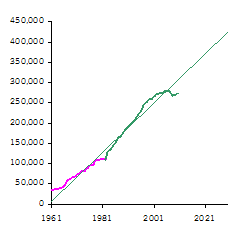Oh, jeez, this is like shooting fish in a barrel: a picture-perfect demonstration of how not to estimate future traffic volumes.
On the website of the Southwest Washington Regional Transportation Council, I ran across this doozy of a chart, showing projections for future traffic across the Columbia River between Portland, OR, and Vancouver, WA.

It seems that the chartmaker used a linear regression (which comes standard on most spreadsheet programs) to draw a straight line through traffic data from the early 1960s through 2010, and continue that line through 2030. Then—apparently with a straight face—the Transportation Council presents this line as a “projection” for future traffic volumes, “should current trends continue.”
And since the state of Washington itself hosts the page, you’d be forgiven for thinking that this kind of linear regression is a reasonable way to project future traffic volumes.
But wait, I can use Excel too! Here’s my take, based on the very same data plus a wee bit of historical context:
 When you present the chart this way, traffic across the Columbia River divides into three phases:
When you present the chart this way, traffic across the Columbia River divides into three phases:
- The first phase (1961 through 1982), when there was just one bridge across the Columbia north of Portland, saw fairly consistent traffic growth.
- The second phase (1983 through 2001)—while both the I-5 and I-205 bridges were open, gas prices remained low, the baby boomers entered their peak driving years, and the Northwest economy hummed—saw even faster growth in traffic.
- During phase three (2002 to the present), gas prices started going up in earnest, rush-hour traffic on the CRC bridges neared saturation, the economy roller-coastered, and the baby boomers aged past their peak driving years—and traffic essentially flatlined.
So if you run a linear regression from “current trends”—where “current” is defined as the last decade, excluding what happened in the 1960s through 2001—you wind up with a “projection” of essentially zero traffic growth through 2030.

But more importantly, a linear regression on this data set can generate all sorts of different lines, depending on where you set the starting and ending points. In the animation to the right, I ran a series of linear regressions on the CRC traffic volume data. All of the regressions use 2010 as the endpoint, but the start date ranges from 1983 to 2004. The “projection forward should current trends continue”—the expression used in the transportation council’s chart—is practically whatever you want it to be; all you have to do is choose what you mean by “current trends.”
Luckily for you, I won’t insult your intelligence by claiming that any of these linear regressions represents a legitimate prediction of future traffic trends. An Excel linear regression just doesn’t count as a forecast. So just to be clear: I’m NOT predicting that traffic between Vancouver and Portland will remain flat indefinitely. All I’m saying is that running a linear regression, with no other information for context, is a nonsensical way to make a forecast of the future.
Instead, a real estimate of future traffic would look at macro-economic forecasts, land use projections, future gas prices and fleet mpg, population growth, population age structure, recent trends by age and demographic groups, and a host of other factors. Even with all of that baked in, of course, a forecast will almost certainly be wrong; very few predictions, even the most sophisticated and thoughtful, hit their mark. (For example, the actual track record of the Puget Sound’s transportation model is simply laughable.) But at least the Council would be able to explain their projections without getting red in the face.
As it stands now, though, a regional transportation planning group has presented a “projection” that’s essentially a meaningless, cherry-picked line. At the same time, I notice that the Southwest Washington Regional Transportation Council has voted to support a much wider I-5 bridge. One has to wonder: was their decision to support the wider CRC influenced by their simplistic projections? Or did they create the projection to help justify a decision they were going to make anyway? Either way, it’s a bit embarrassing.


Comments are closed.